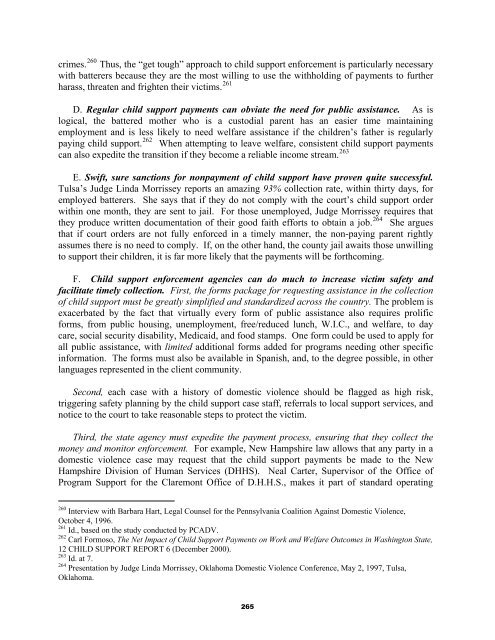A Judge’s Guide
A Judge’s Guide
A Judge’s Guide
You also want an ePaper? Increase the reach of your titles
YUMPU automatically turns print PDFs into web optimized ePapers that Google loves.
crimes. 260 Thus, the “get tough” approach to child support enforcement is particularly necessary<br />
with batterers because they are the most willing to use the withholding of payments to further<br />
harass, threaten and frighten their victims. 261<br />
D. Regular child support payments can obviate the need for public assistance. As is<br />
logical, the battered mother who is a custodial parent has an easier time maintaining<br />
employment and is less likely to need welfare assistance if the children’s father is regularly<br />
paying child support. 262 When attempting to leave welfare, consistent child support payments<br />
can also expedite the transition if they become a reliable income stream. 263<br />
E. Swift, sure sanctions for nonpayment of child support have proven quite successful.<br />
Tulsa’s Judge Linda Morrissey reports an amazing 93% collection rate, within thirty days, for<br />
employed batterers. She says that if they do not comply with the court’s child support order<br />
within one month, they are sent to jail. For those unemployed, Judge Morrissey requires that<br />
they produce written documentation of their good faith efforts to obtain a job. 264 She argues<br />
that if court orders are not fully enforced in a timely manner, the non-paying parent rightly<br />
assumes there is no need to comply. If, on the other hand, the county jail awaits those unwilling<br />
to support their children, it is far more likely that the payments will be forthcoming.<br />
F. Child support enforcement agencies can do much to increase victim safety and<br />
facilitate timely collection. First, the forms package for requesting assistance in the collection<br />
of child support must be greatly simplified and standardized across the country. The problem is<br />
exacerbated by the fact that virtually every form of public assistance also requires prolific<br />
forms, from public housing, unemployment, free/reduced lunch, W.I.C., and welfare, to day<br />
care, social security disability, Medicaid, and food stamps. One form could be used to apply for<br />
all public assistance, with limited additional forms added for programs needing other specific<br />
information. The forms must also be available in Spanish, and, to the degree possible, in other<br />
languages represented in the client community.<br />
Second, each case with a history of domestic violence should be flagged as high risk,<br />
triggering safety planning by the child support case staff, referrals to local support services, and<br />
notice to the court to take reasonable steps to protect the victim.<br />
Third, the state agency must expedite the payment process, ensuring that they collect the<br />
money and monitor enforcement. For example, New Hampshire law allows that any party in a<br />
domestic violence case may request that the child support payments be made to the New<br />
Hampshire Division of Human Services (DHHS). Neal Carter, Supervisor of the Office of<br />
Program Support for the Claremont Office of D.H.H.S., makes it part of standard operating<br />
260<br />
Interview with Barbara Hart, Legal Counsel for the Pennsylvania Coalition Against Domestic Violence,<br />
October 4, 1996.<br />
261<br />
Id., based on the study conducted by PCADV.<br />
262<br />
Carl Formoso, The Net Impact of Child Support Payments on Work and Welfare Outcomes in Washington State,<br />
12 CHILD SUPPORT REPORT 6 (December 2000).<br />
263<br />
Id. at 7.<br />
264<br />
Presentation by Judge Linda Morrissey, Oklahoma Domestic Violence Conference, May 2, 1997, Tulsa,<br />
Oklahoma.<br />
265


